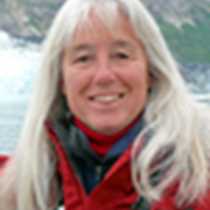Williams Cove/Tracy Arm
The National Geographic Sea Bird departed from the dock in Juneau last night and cruised southward. We crossed “the bar” (submerged terminal moraine) into Holkham Bay in the early morning and dropped our anchor in Williams Cove. Guests who were out on the decks observed Pacific loons, surf scoters, and marbled murrelets on the water.
After staff introductions and briefings about Zodiacs, hiking, and kayaking, we disembarked for the various activities. The Zodiac riders and kayakers were able to observe icebergs that had calved from a glacier more than twenty miles away. There were also small waterfalls on the far side of the inlet. One group walk went along the forest edge for an introduction to the temperate rain forest ecology, and another walk ascended through the forest and emerged onto a muskeg (peat bog). There was enough mud for everyone.
When everyone was back aboard, we pulled the anchor and cruised into Tracy Arm—a classic deep, narrow, and tortuous fjord with precipitous rock walls that soar directly up from sea level. Waterfalls and spectacular mountain scenery could be seen in all directions. Glacial silt imparts an astonishing greenish hue to the water and with icebergs all around us one guest commented that it was like we were floating in a giant Margarita. John Muir visited this area in 1879 and 1880 and described it as a “wild unfinished Yosemite.” His visits to Alaska helped confirm his suspicion that Yosemite was also carved by glaciers.
At Sawyer Island, where the waterway splits into two fingers, we chose the left (north) waterway in which to lower our Zodiacs to get an intimate (yet safe) look at Sawyer Glacier, which tumbles from the mountains of the Coast Range all the way to the sea. We at once felt both awed and humbled by the power of this huge river of ice in close proximity. This glacier has been retreating, exposing colorful rock that has been under ice for thousands of years. The sun came out to illuminate the mountains, ice and cascades of the fjord. A few harbor seals poked their rounded heads above the surface, and it was exciting to find a peregrine falcon feeding on a bird.
After our Zodiac tours, the National Geographic Sea Bird cruised into the south finger where we had a magnificent view of South Sawyer Glacier and hundreds of harbor seals that were safely hauled out on icebergs. The seals bear their pups on the icebergs, a habitat that may vanish with the continued recession of tidewater glaciers. The late afternoon light was beautiful and the scenery stunning. It was worth staying out on the decks through recap and right up until the doors of the dining room opened for dinner.




